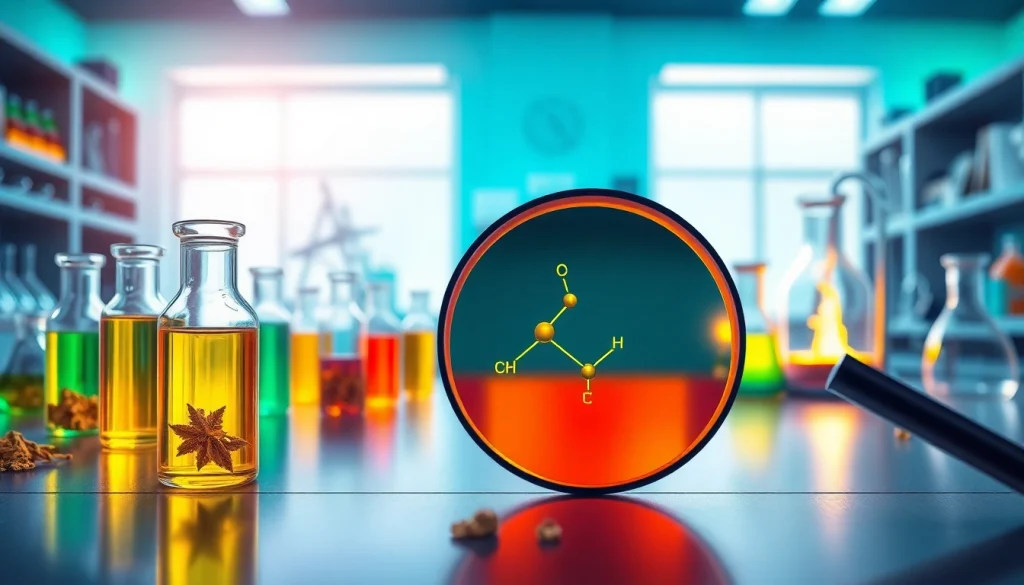Synthetic Cannabinoids: Understanding Their Composition, Effects, and Risks

Introduction to Synthetic Cannabinoids
Synthetic Cannabinoids are a class of man-made chemicals that mimic the effects of naturally occurring cannabinoids found in the cannabis plant. Often marketed as “legal highs,” these substances can be significantly more potent than THC (tetrahydrocannabinol), the primary psychoactive component of cannabis. Their usage has rapidly expanded in recreational and some medicinal contexts, raising urgent questions about their safety and legal regulation. Understanding these substances, including their composition, effects, and potential risks, is crucial for consumers, healthcare providers, and policymakers alike.
Many people are unaware of the dangers associated with Synthetic Cannabinoids, often believing them to be harmless alternatives to natural cannabis products. To navigate the complexities surrounding Synthetic Cannabinoids, it is essential to grasp their history, current uses, and the potentially hazardous consequences that arise from their misuse. For comprehensive information and resources on this topic, you can explore Synthetic Cannabinoids.
Definition of Synthetic Cannabinoids
Synthetic Cannabinoids are laboratory-created chemicals designed to interact with the cannabinoid receptors in the brain. These substances can be found in a variety of forms, including dried plant materials that have been sprayed with synthetic chemicals or liquids meant for vaporizing or edibles. Unlike natural cannabis, which is derived from the Cannabis plant, these synthetic versions do not appear in their natural state. The unpredictable nature of these compounds often leads to severe and sometimes life-threatening health issues.
History and Development
The development of Synthetic Cannabinoids began in the 1980s and 1990s when researchers were studying the endocannabinoid system’s therapeutic potential. However, it wasn’t until the early 2000s that these substances gained popularity in the recreational drug market, often under names such as “Spice” or “K2.” These products were marketed as herbal blends, claiming to deliver a “safe” high similar to that of cannabis without the legal repercussions associated with marijuana.
Initially, many people viewed them as safer alternatives, but as more reports of adverse effects began surfacing, the dangers of Synthetic Cannabinoids became more apparent. Since their introduction to the market, thousands of different synthetic cannabinoid compounds have been created, each with varying effects and potency, complicating the potential for regulation and understanding of their health impacts.
Current Uses and Misuse
Synthetic Cannabinoids are commonly used for recreational purposes, with individuals seeking the high associated with THC while attempting to avoid legal restrictions. They are frequently sold in convenience stores, online, or at parties, marketed in attractive packaging as “herbal incense” or “potpourri.” However, their unregulated status means that users are often unaware of the specific chemicals they are consuming.
Misuse of Synthetic Cannabinoids has been linked to various psychological and physiological issues, including anxiety, paranoia, hallucinations, seizures, and even death in extreme cases. This misuse typically stems from a lack of awareness regarding the actual contents of these products and the risks associated with consumption.
Mechanism of Action
How Synthetic Cannabinoids Affect the Brain
Synthetic Cannabinoids mimic the effects of natural cannabinoids by binding to cannabinoid receptors in the brain, particularly CB1 and CB2 receptors. These interactions can elicit effects ranging from euphoria and altered perception to anxiety and negative psychotropic symptoms. Unlike THC, which binds to receptors partially, most synthetic cannabinoids engage with these receptors more strongly, leading to heightened effects and increased risk for negative outcomes.
The specific action of each synthetic cannabinoid can vary significantly—some may produce effects similar to THC, while others may lead to more intense and unpredictable experiences. The sheer variability in the potency and chemical structure of these substances contributes to their potential for addiction and adverse health outcomes.
Comparison with Natural Cannabinoids
Natural cannabinoids, such as THC and CBD (cannabidiol), are compounds extracted from the Cannabis plant and have been studied extensively for their effects on the body and mind. In contrast, Synthetic Cannabinoids can be engineered to bypass the body’s natural regulatory mechanisms, affecting users in unpredictable ways.
This enhanced potency can increase the likelihood of addiction, where individuals feel compelled to seek out and consume these substances beyond their intended use. While some users may expect a similar experience to that of traditional cannabis, the unpredictable nature and sometimes severe consequences of Synthetic Cannabinoids create a very different reality.
Potential for Addiction and Abuse
Research indicates that Synthetic Cannabinoids have a high potential for abuse. High potency and rapid onset of effects can lead users to consume larger amounts more frequently, reinforcing addictive behaviors. Withdrawal symptoms may develop for regular users, including irritability, insomnia, and cravings, contributing to a cycle of dependency.
The lack of information about specific synthetic compounds makes it difficult for healthcare providers to offer accurate guidance to those struggling with addiction or misuse. As new compounds emerge consistently, staying informed becomes essential for effective treatment strategies and harm reduction measures.
Health Effects and Risks
Short-term Effects of Synthetic Cannabinoids
Short-term effects of Synthetic Cannabinoids can vary widely among individuals and may include symptoms such as:
- Altered perception of reality
- Increased heart rate
- Nausea or vomiting
- Severe anxiety or panic attacks
- Hallucinations
- Agitation and aggression
While some individuals may report feelings of euphoria or relaxation, these positive effects are often outweighed by the potential for negative psychological experiences.
Long-term Health Risks
Long-term use of Synthetic Cannabinoids can result in serious health complications, including:
- Psychiatric disorders, including depression and anxiety
- Cardiovascular issues
- Kidney injury
- Respiratory problems (if smoked)
- Increased risk of seizures
The long-term physiological and psychological implications of frequent use are not yet fully understood, thus making synthetic cannabinoids a particularly concerning public health issue.
Emergency Response and Toxicity
In cases of overdose or adverse reaction to Synthetic Cannabinoids, emergency medical intervention may be necessary. Symptoms requiring immediate attention may include severe agitation, rapid heart rate, psychotic episodes, or unconsciousness. Health professionals may administer treatments such as sedation, intravenous fluids, or supportive care to manage the situation effectively.
The toxic potential of Synthetic Cannabinoids highlights the need for widespread public education and urgent action regarding their regulation and usage. Awareness of the risks associated with these substances is critical for reducing incidence rates and improving individual outcomes in emergency situations.
Legal Status and Regulation
Overview of Legal Regulations
The legal status of Synthetic Cannabinoids varies significantly worldwide. In many countries, their sale and distribution are illegal, yet manufacturers often find loopholes by altering chemical structures to create new compounds that evade regulations. As a result, new versions of these substances continually enter the market.
Legislation tends to lag behind the rapid developments in synthetic cannabinoid production, making it challenging for law enforcement agencies to keep pace with changing formulations and their potential harms.
Comparison of Laws Across Regions
In regions where cannabis has been legalized, the regulatory framework surrounding Synthetic Cannabinoids can become particularly complex. Some states have actively pursued measures to curb the sale of these substances, while others have focused on education and prevention. Various nations take different approaches based on cultural norms, health implications, and economic considerations.
Understanding these differences is crucial for navigating legal landscapes while adequately supporting efforts to mitigate the adverse effects of Synthetic Cannabinoids.
Impact of Legalization Efforts
The legalization of marijuana in various states has led to debates about the regulation of Synthetic Cannabinoids. Some advocates argue that legalization will help reduce the demand for synthetic alternatives by providing consumers with safe, regulated options. Conversely, opponents warn of the potential for increased misuse among populations unsure of the differences between natural and synthetic products.
The ongoing debate necessitates a careful balance within legislative efforts to ensure health and safety, inform consumers, and eliminate harmful substances from the market.
Future Directions in Research and Safety
Emerging Trends in Synthetic Cannabinoids
As the landscape of Synthetic Cannabinoids continues to evolve, several trends are emerging. Researchers emphasize the importance of understanding how these substances impact health, leading to collective efforts to analyze new synthetic compounds and their effects. Innovations in drug testing and monitoring are also on the rise, helping to identify and report incidents involving these substances more quickly.
Moreover, the interplay between the cannabis community and synthetic products is becoming an area of significant exploration, as discussions around harm reduction strategies gain attention.
Research Challenges and Opportunities
Challenges in researching Synthetic Cannabinoids largely stem from their rapid evolution and changing chemical formulas. The varying potency and lack of regulation hinder the ability to carry out comprehensive studies. Nevertheless, opportunities exist for advancements in toxicology research, consumer education, and policy development to address the public health impact of these substances.
By collaborating with health professionals, community organizations, and policymakers, strategies can emerge to effectively educate individuals on the dangers of Synthetic Cannabinoids and provide support for those affected by their misuse.
Best Practices for Safety and Education
Promoting safety around Synthetic Cannabinoids involves several best practices, including:
- Developing educational campaigns aimed at raising awareness regarding the dangers of synthetic products
- Providing resources for users and healthcare providers to identify signs of misuse and effective intervention strategies
- Encouraging harm reduction methods, such as safe consumption practices and access to addiction treatment programs
- Advocating for increased regulatory measures and enforcement to minimize the availability of dangerous synthetic substances
Through these strategic approaches, the aim is to provide informed choices for individuals while creating a safer community overall.







